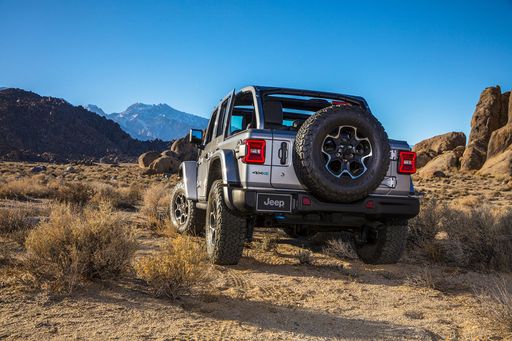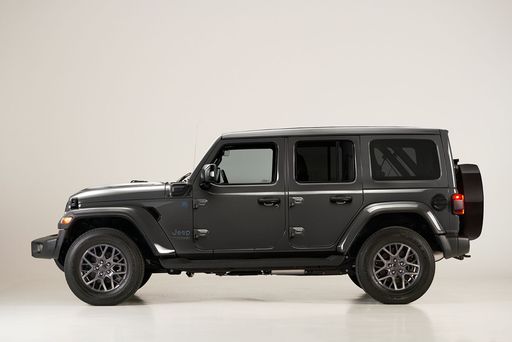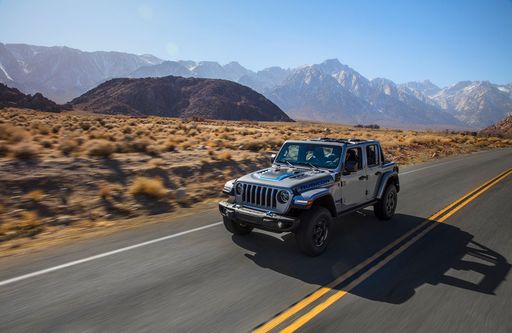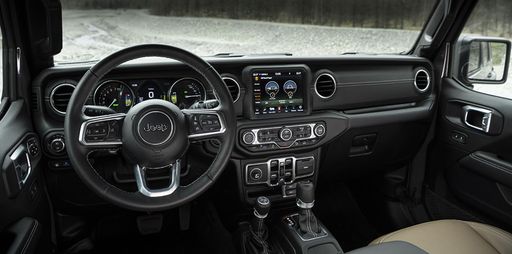Jeep Wrangler vs VW Transporter Transporter – Differences & prices compared
Compare performance, boot space, consumption and price in one view.
Find out now: which car is the better choice for you – Jeep Wrangler or VW Transporter Transporter?
The Jeep Wrangler (Off-Roader) comes with a Plugin Hybrid engine and Automatic transmission. In comparison, the VW Transporter Transporter (Cargo Van) features a Diesel, Plugin Hybrid or Electric engine with Manuel or Automatic transmission.
When it comes to boot capacity, the Jeep Wrangler offers 533 L, while the VW Transporter Transporter provides – depending on how much space you need. If you’re looking for more power, decide whether the 380 HP of the Jeep Wrangler or the 286 HP of the VW Transporter Transporter suits your needs better.
In terms of consumption, the values are 3.30 L per 100 km for the Jeep Wrangler, and 21.90 kWh7.10 L for the VW Transporter Transporter.
Price-wise, the Jeep Wrangler starts at 69900 £, while the VW Transporter Transporter is available from 37500 £. Compare all the details and find out which model fits your lifestyle best!
Jeep Wrangler
The Jeep Wrangler is a symbol of rugged adventure and off-road capability, renowned for its distinctive boxy design and iconic seven-slot grille. Its interior blends practicality with modern technology, providing a comfortable environment whether you're navigating city streets or challenging terrains. With a loyal fan base, the Wrangler continues to capture the spirit of freedom and exploration, making it a favourite among outdoor enthusiasts.
details @ media.stellantis.com
@ media.stellantis.com
 @ media.stellantis.com
@ media.stellantis.com
 @ media.stellantis.com
@ media.stellantis.com
 @ media.stellantis.com
@ media.stellantis.com
 @ media.stellantis.com
@ media.stellantis.com
VW Transporter Transporter
The VW Transporter, a versatile favourite among commercial vehicles, combines practicality with modern design. Its spacious interior offers ample room for both passengers and cargo, making it a reliable choice for businesses and families alike. The vehicle's strong build and advanced technology ensure a smooth and efficient driving experience in various conditions.
details

|
|
|
|
|
Costs and Consumption |
|
|---|---|
|
Price
69900 - 71600 £
|
Price
37500 - 60800 £
|
|
Consumption L/100km
3.3 - 4 L
|
Consumption L/100km
7.1 - 8.4 L
|
|
Consumption kWh/100km
-
|
Consumption kWh/100km
21.9 - 24.4 kWh
|
|
Electric Range
38 - 42 km
|
Electric Range
56 - 331 km
|
|
Battery Capacity
-
|
Battery Capacity
11.8 - 63.8 kWh
|
|
co2
74 - 91 g/km
|
co2
0 - 220 g/km
|
|
Fuel tank capacity
65 L
|
Fuel tank capacity
55 L
|
Dimensions and Body |
|
|---|---|
|
Body Type
Off-Roader
|
Body Type
Cargo Van
|
|
Seats
5
|
Seats
2 - 5
|
|
Doors
5
|
Doors
4 - 5
|
|
Curb weight
2276 - 2383 kg
|
Curb weight
1872 - 2462 kg
|
|
Trunk capacity
533 L
|
Trunk capacity
-
|
|
Length
4882 mm
|
Length
5050 - 5450 mm
|
|
Width
1894 mm
|
Width
2032 mm
|
|
Height
1838 - 1848 mm
|
Height
1966 - 1985 mm
|
|
Payload
520 - 536 kg
|
Payload
755 - 1259 kg
|
Engine and Performance |
|
|---|---|
|
Engine Type
Plugin Hybrid
|
Engine Type
Diesel, Plugin Hybrid, Electric
|
|
Transmission
Automatic
|
Transmission
Manuel, Automatic
|
|
Transmission Detail
Automatic Gearbox
|
Transmission Detail
Manual Gearbox, Automatic Gearbox
|
|
Drive Type
All-Wheel Drive
|
Drive Type
Front-Wheel Drive, All-Wheel Drive, Rear-Wheel Drive
|
|
Power HP
380 HP
|
Power HP
110 - 286 HP
|
|
Acceleration 0-100km/h
6.50 s
|
Acceleration 0-100km/h
7.4 - 16.9 s
|
|
Max Speed
156 - 177 km/h
|
Max Speed
112 - 150 km/h
|
|
Torque
637 Nm
|
Torque
310 - 415 Nm
|
|
Number of Cylinders
4
|
Number of Cylinders
4
|
|
Power kW
280 kW
|
Power kW
81 - 210 kW
|
|
Engine capacity
1995 cm3
|
Engine capacity
1996 - 2488 cm3
|
General |
|
|---|---|
|
Model Year
2024
|
Model Year
2025
|
|
CO2 Efficiency Class
B
|
CO2 Efficiency Class
G, A
|
|
Brand
Jeep
|
Brand
VW
|
Jeep Wrangler
Introduction to the Iconic Jeep Wrangler
The Jeep Wrangler has long been synonymous with off-road capability and rugged design. With its roots deeply embedded in adventure and exploration, the Wrangler combines classic styling with modern innovations. In its latest iterations, it continues to enhance its reputation as a robust, yet stylish, off-roader suitable for a variety of terrains and conditions.
Technical Specifications and Performance
The 2023 Jeep Wrangler models offer a range of options, with engines that are designed to deliver powerful performance and efficiency. The available engine configurations include advanced Plug-in Hybrid options, as well as traditional petrol engines. All options are paired with an automatic transmission and benefit from the capability of an all-wheel-drive system.
Power output varies from 272 to 380 PS, catering to different driving preferences and demands. The Plug-in Hybrid variant impresses with a consumption as low as 3.3 L/100km, offering an electric range of up to 48 km—ideal for urban commutes and reducing environmental impact. For those wanting a more traditional power experience, the petrol engines deliver robust performance with an acceleration of 0-100 km/h in just 6.5 to 7.6 seconds, depending on the variant.
Innovative Features and Sustainability
The Jeep Wrangler is not just about raw power; it also embodies sustainability with its hybrid technologies. The Plug-in Hybrid models are designed to offer a blend of efficiency and environmentally friendly driving experience. By integrating electric motor capabilities with traditional fuel engines, these models ensure lower emissions and enhanced fuel economy.
Beyond mechanical advancements, the modern Wrangler incorporates cutting-edge technology in its interior. With a suite of safety features and a sophisticated infotainment system, it ensures both driver and passengers enjoy a comfortable and secure journey.
Exterior Design and Interior Comfort
The exterior of the Jeep Wrangler remains a testament to its enduring legacy, featuring the iconic seven-slot grille and round headlights. Yet, it manages to blend this classic look with modern aesthetics, providing a more refined appearance that does not compromise its rugged appeal.
Inside, the Wrangler offers a spacious interior with seating for five, ensuring comfort during long drives. Thoughtfully designed with high-quality materials, the cabin provides both functionality and style. With a generous boot space of 533 litres, it caters to both city drivers and adventure seekers alike.
Versatility and All-Terrain Capability
True to its heritage, the Jeep Wrangler excels in off-road conditions. Thanks to its high ground clearance, robust suspension system, and advanced all-terrain technology, it is perfectly equipped to handle challenging terrains with ease. Whether it's muddy trails or rocky paths, the Wrangler stands ready to tackle any obstacle.
Conclusion: A Vehicle for All Adventures
The 2023 Jeep Wrangler continues to embody the spirit of adventure that has defined the brand for decades. With a combination of powerful performance, advanced hybrid technology, and timeless design, it remains a top choice for those who seek a vehicle as versatile and robust as their lifestyle. Whether navigating urban streets or exploring off-beaten paths, the Wrangler proves once again why it is an enduring favourite among off-road enthusiasts.
VW Transporter Transporter
Revolutionizing Utility: The VW Transporter T7
The latest iteration of the VW Transporter, known widely as the Transporter T7, marks a significant evolution in utility vehicle design and functionality. As a mainstay in the VW lineup, the Transporter T7 comes with a plethora of options, ensuring that it meets a variety of professional and personal needs.
Diverse Models to Fit Every Need
For 2025, the VW Transporter T7 is available in multiple configurations, ranging from efficient diesel engines to innovative hybrid systems. The conventional models are powered by a 2.0 TDI diesel engine, offering three power outputs: 110 HP, 150 HP, and a vigorous 204 HP. For those seeking a more sustainable option, the 2.5 eHybrid model provides a combined power output of 233 HP with an electric range of 56 km, thanks to its 11.8 kWh battery.
Innovative Technical Aspects
Underpinning the technical innovations of the Transporter T7 is VW's dedication to cutting-edge engineering. The diesel engines provide torque ranging from 310 Nm up to 390 Nm, ensuring robust performance across the lineup. Moreover, the T7 offers configurations with either manual or automatic gearboxes, catering to different driving preferences.
The availability of front-wheel drive and the 4MOTION all-wheel-drive system across the range enhances versatility, allowing the Transporter T7 to tackle various terrains with ease. With body lengths extending to 5450 mm and a payload capacity of up to 1259 kg, the Transporter T7 stands as a paragon of practicality for transporting goods or accommodating passengers.
Comfort and Design Revolution
Beyond performance, the VW Transporter T7 has been designed with driver comfort and ergonomic efficiency in mind. The cabins offer ample seating configurations, supporting both two-seat and five-seat layouts. The inclusion of modern conveniences elevates the driving experience, making long hauls more manageable and stress-free.
The exterior dimensions, with a width of 2032 mm and a height up to 1969 mm, marry the classic robust design with a contemporary touch, making the Transporter T7 a visual centerpiece in any fleet.
Economical and Environmental Impact
Economic efficiency is another critical aspect of the VW Transporter T7's design philosophy. With diesel fuel tank capacities between 55 and 63 liters, and an emphasis on improving mileage with each engine variant, operational costs are kept at a minimum. Additionally, the eHybrid model not only offers environmental benefits but also presents substantial savings on fuel through its electric range capability.
Conclusion: The Transporter T7 Legacy Continues
The VW Transporter T7 furthers the legacy of its predecessors by combining practicality, innovation, and eco-friendliness. Whether utilized for business in its cargo van capacity or adapted for personal use with seating comforts, the Transporter T7 is set to remain a critical player in the automotive sector, pushing the boundaries of what a multi-purpose van can achieve.
Which drive types are available for the Jeep Wrangler?
Available as All-Wheel Drive.
The prices and data displayed are estimates based on German list prices and may vary by country. This information is not legally binding.
